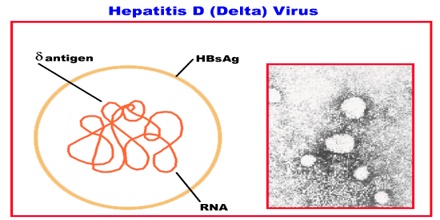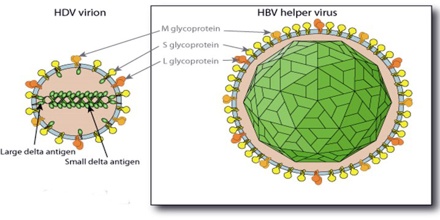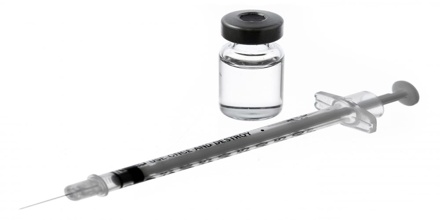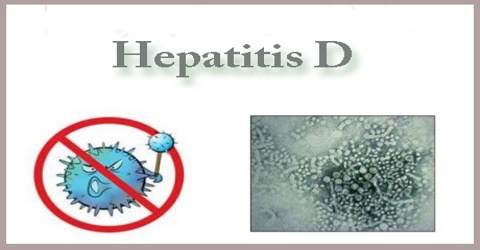Describe about Hepatitis D
Hepatitis D is a liver disease in both acute and chronic forms caused by the hepatitis D virus (HDV) that requires HBV for its replication. Hepatitis D infection cannot occur in the absence of hepatitis B virus. The coinfection or super infection of HDV with HBV causes a more severe disease than HBV monoinfection. In combination with hepatitis B virus, hepatitis D has the highest fatality rate of all the hepatitis infections, at 20%.

Hepatitis D, also known as the delta virus, is an infection that causes the liver to become inflamed. Hepatitis D is transmitted through percutaneous or mucosal contact with infectious blood and can be acquired either as a coinfection with HBV or as superinfection in people with HBV infection. There is no vaccine for Hepatitis D, but it can be prevented in persons who are not already HBV-infected by Hepatitis B vaccination.
HDV is one of many forms of hepatitis. Other types include:
- Hepatitis A, which is transmitted through direct contact with feces or indirect fecal contamination of food or water
- Hepatitis B, which is spread through exposure to body fluids, including blood, urine, and semen
- Hepatitis C, which is spread by exposure to contaminated blood or needles
- Hepatitis E, which is a short-term and self-resolving version of hepatitis transmitted through indirect fecal contamination of food or water

Hepatitis D can be acute or chronic. Acute hepatitis D occurs suddenly and typically causes more severe symptoms. It may go away on its own. If the infection lasts for six months of longer, the condition is known as chronic hepatitis D. As chronic hepatitis D progresses, the chances of complications increase. Many people with the condition eventually develop cirrhosis, or severe scarring of the liver.
It is estimated that globally, 5% of HBsAg positive people are coinfected with HDV and the distribution is worldwide. High-prevalence areas include the Mediterranean, Middle East, Pakistan, Central and Northern Asia, Japan, Taiwan, Greenland and parts of Africa (mainly the horn of Africa and West Africa), the Amazon Basin and certain areas of the Pacific. Prevalence is low in North America and Northern Europe, South Africa, and Eastern Asia.
Causes and Symptoms of Hepatitis D
Hepatitis D only occurs in people who have hepatitis B. This is because hepatitis D virus is a defective (incomplete) virus and requires hepatitis B virus to survive and multiply. Hepatitis D is spread when infectious body fluids (blood, saliva, semen and vaginal fluid) come into contact with body tissues beneath the skin, for example, through needle puncture or broken skin or mucous membranes the thin moist lining of many parts of the body such as the mouth, throat and genitals.

Sometimes people can become infected with both hepatitis B and hepatitis D at the same time (co-infection). While most people with co-infection will get rid of both viruses on their own, there is a higher risk (2 to 20%) of developing fulminant (overwhelming) hepatitis (acute liver failure). When someone with hepatitis B virus later becomes infected with hepatitis D virus (superinfection) acute hepatitis D develops.
Hepatitis D doesn’t always cause symptoms. When symptoms do occur, they often include:
- yellowing of the skin and eyes, which is called jaundice
- joint pain
- abdominal pain
- vomiting
- loss of appetite
- dark urine
- fatigue
The symptoms of hepatitis B and hepatitis D are similar, so it can be difficult to determine which disease is causing your symptoms. In some cases, hepatitis D can make the symptoms of hepatitis B worse. It can also cause symptoms in people who have hepatitis B but who never had symptoms.
Diagnosis, Treatment and Prevention
The diagnosis is based on signs and symptoms and confirmed with a serology blood test (serology) and/or PCR (polymerase chain reaction) test in a pathology laboratory. Positive serology indicates previous exposure to hepatitis D virus while PCR testing is used to confirm the presence of the virus.

The only known way to prevent hepatitis D is to avoid infection with hepatitis B. People can take the following preventive measures to reduce their risk for hepatitis B:
Get vaccinated. There’s a vaccine for hepatitis B that all children should receive. Adults who are at high risk for infection, such as those who abuse intravenous drugs, should also be vaccinated. The vaccination is usually given in a series of three injections over a period of six months.
Practice safer sex – use condoms consistently and correctly.
Avoid using illegal drugs. Avoid or stop using illegal drugs that can be injected, such as heroin or cocaine. If you’re unable to stop using drugs, make sure to use a sterile needle each time you inject them. Never share needles with other people.
Be cautious about tattoos and piercings. Go to a trustworthy shop whenever you get a piercing or tattoo. Ask how the equipment is cleaned and make sure the employees use sterile needles.
There is no specific treatment for acute or chronic HDV infection. Persistent HDV replication is the most important predictor of mortality and the need for antiviral therapy. Pegylated interferon alpha is the only drug effective against HDV; antiviral nucleotide analogues for HBV have no or limited effect on HDV replication. The optimal duration of therapy is not well defined, nor how long patients need to be HDV RNA negative after the end of therapy to achieve a sustained virological response. More than 1 year of therapy may be necessary.
















